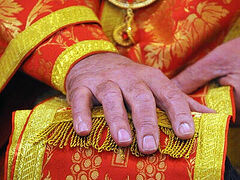Nea Makri, Attica, Greece, May 31, 2024
 Photo: orthodoxianewsagency.gr
Photo: orthodoxianewsagency.gr
Gerondissa Makaria (Desipri), former abbess of the Holy Annunciation Monastery in Nea Makri, who was vouchsafed to uncover the relics of St. Ephraim of Nea Makri in 1950, has been formally proposed for canonization.
The joyous news was announced by Metropolitan Kirill of Kifissia while serving at the monastery yesterday. The hierarch has already turned over the relevant file and documents to the Holy Synod of the Church of Greece, which will then pass it on to the Patriarchate of Constantinople, reports the Orthodoxia News Agency.
Gerondissa Theodosia, who governed the monastery after Gerondissa Makaria was also a holy woman. When she reposed on the feast of the Nativity of the Theotokos in 2022 at the age of 103, the whole monastery was filled with a bright light.
***
 Photo: orthodoxianewsagency.gr
Photo: orthodoxianewsagency.gr
Gerondissa Makaria was born on March 12, 1911, in Tinos. At the age of 19, she decided she wanted to become a nun. During the occupation, she lovingly cared for the children of prisoners. In 1945, she visited the then-men’s monastery on Mount Amomon, where she lived for several years under difficult conditions. Her health was greatly tested during this time. She slept in the ruins of the monastery, without windows and coverings, enduring every hardship.
Moved by Divine inspiration, she set up a small cell there and began clearing the ruins of the old church to reconstruct it. She often pondered that monks had lived there over the centuries and prayed to meet or be revealed one of them. A voice, initially faint but growing stronger in her soul over time, told her: “Dig and you will find what you desire,” until a spot in the monastery courtyard was revealed to her.
On January 3, 1950, she instructed a worker to dig at the specific spot her soul had indicated. Despite the worker’s initial reluctance and preference to dig elsewhere, he was persuaded by her pleas and prayers to start digging. The spot contained a half-ruined fireplace, wall, and remnants indicating it was once a monk’s cell. The first discovery was a head, and the area emitted a fragrance.
“I knelt reverently and kissed the relic of the saint, deeply feeling the extent of his martyrdom. My soul was filled with joy, and I had acquired a great treasure. Carefully removing the soil, I saw the harmony of his relic, which, despite centuries in the ground, had not decayed,” wrote Mother Makaria, describing the profound events.
With care, Abbess Makaria removed the entire relic and placed it in a niche above the grave. It was evident that he was a cleric, as his cassock remained intact.
That night, while reading Vespers, Mother Makaria heard footsteps coming from the grave, echoing to the church door. There she first saw him. He was tall with small round eyes, long black beard reaching his neck, dressed in monastic garb. In one hand, he held a flame and blessed with the other. He asked to be removed from the niche where he was placed. The next day, the Abbess cleaned the bones and placed them in a niche in the church sanctuary.
That same night, the saint appeared in her dream, thanked her, and revealed his name: Ephraim. The relic of St. Ephraim has been kept there since, with hundreds of faithful visiting daily to seek his blessing and assistance. By God’s grace, the saint has performed thousands of miracles. In the monastery courtyard, protected by a structure built around it, stands the mulberry tree where St. Ephraim took his last breath.
Without financial resources, she maintained an orphanage until 1980 with about 70 school-aged children, providing them with shelter, food, clothing, and elementary education. Those who excelled academically were supported through higher education, and today they testify that she “nourished them from nothing.”
Though lacking a university education, she published Patristic texts, Ascetic Words of Saint Basil the Great, and composed a Supplicatory Canon and Akathist Hymn to her beloved St. Ephraim, recording and gradually publishing his miracles in 16 volumes to support and strengthen the faithful.
The Lord of Glory allowed Mother Makaria, in her old age, to bear a great cross. She bore it with patience and silence, facing her trial as a blessing from God. Her passing was peaceful and saintly, as she had predicted more than 20 years prior.
Her holy soul, surely guided by her great martyr St. Ephraim, ascended to the Heavens after receiving the Holy Mysteries. It was Friday, the feast of St. George the Trophy-Bearer, April 23, 1999.
Today, her much-suffered venerable body lies in the remote grave she had dug years earlier in the courtyard of the monastery, where by God’s grace, she was the foundress and abbess for half a century, “to hear the hymns and witness the glorious and wondrous deeds the saint performs for those who come to his holy monastery with faith.”
Follow OrthoChristian on Twitter, Vkontakte, Telegram, WhatsApp, MeWe, and Gab!



